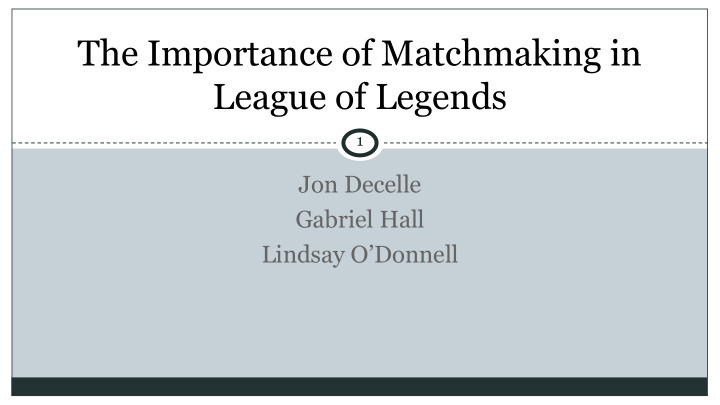



The Importance of Matchmaking in League of Legends 1 Jon Decelle Gabriel Hall Lindsay O’Donnell
Section 1 2 Introduction and Problem Statement
Online Games 3 • In online games, players connect to one another over a network and play with each other. • Some games are 1v1, while others are team based. • In many of these games, players’ skill levels can vary widely. • For enjoyment, players want to play with other players of similar skill.
Matchmaking 4 • Matchmaking places players of similar skill together in a match. • Better matchmaking algorithms form more even matches. • Matchmaking needs to be fast
Multiplayer Online Battle Arena (MOBA) 5 • Competitive, team based • Win the game through killing enemy structures • MOBAs are session based, so players develop skill and increase their ranking by winning games
League of Legends (LoL) 6 • Most popular current day MOBA [Forbes 2012] • Free to Play • Developed by Riot Games in 2009 • WPI has many LoL players to study
Ranking and Matchmaking in LoL 7 • Each player has a visible rank and a hidden matchmaking rating (MMR) • This rating is based on the Elo formula, originally designed for chess • LoL ranks: Bronze, Silver, Gold, Platinum, Diamond, Master, and Challenger.
Research Questions 8 • How balanced is matchmaking in LoL? • How long do players wait for a match? • How do players perceive how well matchmaking works? • What factors affect player enjoyment?
Section 2 9 Study Methodology
Study Methodology Overview 10 ● Collect player ranks to determine how evenly matched teams were by rank ● Collect player perceptions of how even game turned out ● Collect game data to show how even game was statistically ● Compare these to see how much of an impact matchmaking has on game
Study Advertising 11 ● Solicited subjects by emailing IMGD majors, Gaming club, and asking friends ● Offered open time slots for subjects to come in ● Held studies on the weekend when more people are generally free
Study Regulations 12 ● Players signed consent forms ● Players set up their game settings ● Asked to play 5v5 games, solo queue only as this affects the matchmaking ● Play Ranked if possible ○ Uses their Ranked MMR which is represented by their visible rank
Surveys 13 ● Collected demographic player information pre-game ● Collected player perceptions post-game ● Done before and after each game ○ Game was fresh in player’s mind
Environment 14 ● Computer lab where all the players could see, hear, and talk to one another during games. ● Many subjects came in groups ○ Although they were playing separately, often interacted
Matchmaking Data Collection 15 ● Collected ranks of each player in each game through third party website while game in progress ● lolnexus.com
Player Survey 16 ● After each game: ○ Game enjoyability ○ Game evenness overall and at different times during game ○ Reasons for win or loss ○ Outlier players
Game Data 17 ● Collected game data from Riot’s match history website: ○ Gold difference at 20 minutes and at the end of game ○ Kills for each team ○ Game time ○ KDA for each player ○ Position played
Even vs Uneven 18 ● There are many measures to show how even or uneven a game was: ○ Kill difference ○ Gold difference (Gold is obtained by killing enemies and enemy structures) ○ Game Time (If one team is far ahead, they are likely to finish the game quickly)
Section 3 19 Analysis and Results
Study Results and Demographics 20 ● 23 unique participants ● 3 studies, 5 hours each ● 65 games, 52 complete and valid surveys ○ Website for data collection went down during one study
How does queue time correlate with rank? 21
Does better teamwork lead to higher player enjoyment? 22 Axes: ● ○ x: “How well did your team work together?” y: “How enjoyable was ○ was the game you just played?” ● The line of fit shows the positive correlation between these responses.
Are even games more fun? 23 ● Axes: ○ x: “How even was the game you just played?” ○ y: “How enjoyable was was the game you just played?”
Recommend
More recommend